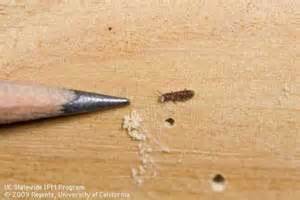Powder Post Beetle Damage
Powder post beetle is a term used to describe several species of small (1/8-3/4 inches long), wood-boring insects which reduce wood to a fine, flour-like powder. Damage is done by the larvae as they create narrow, meandering tunnels in wood as they feed.
Common signs of powder post beetle damage include:
- Crumbling or decaying wood – Wood that appears to be turning to dust or decaying for no apparent reason is a common sign of powder post beetle invasion.
- Tiny holes in wood surfaces – Powder post beetles create minute holes in wood surfaces. If you notice such tiny holes, your home may have been invaded by powder post beetles.
- Tiny feces – Be alert for the presence of tiny feces, especially near areas such as wooden porches, window sills, and furniture.
Powder post beetles damage wood products very, very slowly. Aside from making tiny little holes they make tiny little tunnels  that take a very long time to go anywhere. Many of the most serious infestations of powder post beetles result from people using old lumber from a barn or woodpile behind their house to panel a room or build an addition.
that take a very long time to go anywhere. Many of the most serious infestations of powder post beetles result from people using old lumber from a barn or woodpile behind their house to panel a room or build an addition.
Protect your home and belongings from powder post beetles by making sure that every wood finish is either stained or painted. They will not lay eggs on any kind of wood that has a finish on it. Beetles emerging from finished articles such as furniture were usually in the wood before the finish was applied. Beetles emerging from finished wood can, however, reinfest by laying eggs in their own exit holes; sealing the holes prevents this possibility.
Avoid bringing firewood indoors for storage. Instead, bring wooden logs inside only if you will be burning the logs immediately. Check for any insects or insect damage before bringing any natural or organic material indoors to avoid insect issues in the future. Also avoid bringing in wood that has just been exposed to rain or any other moisture, as powder post beetles (and other insects) often thrive in moist conditions.
Powder post beetles, especially anobiids, have specific moisture requirements for survival. Since wood moisture levels below 13% (during spring and summer) are generally unsuitable for anobiid development/reinfestation, it’s advisable to install a moisture barrier in the crawl space of infested buildings. Covering the soil with 4-6 mil polyethylene reduces movement of moisture into the substructure and reduces the threat of an infestation spreading upwards into walls and upper portions of the building.


































































